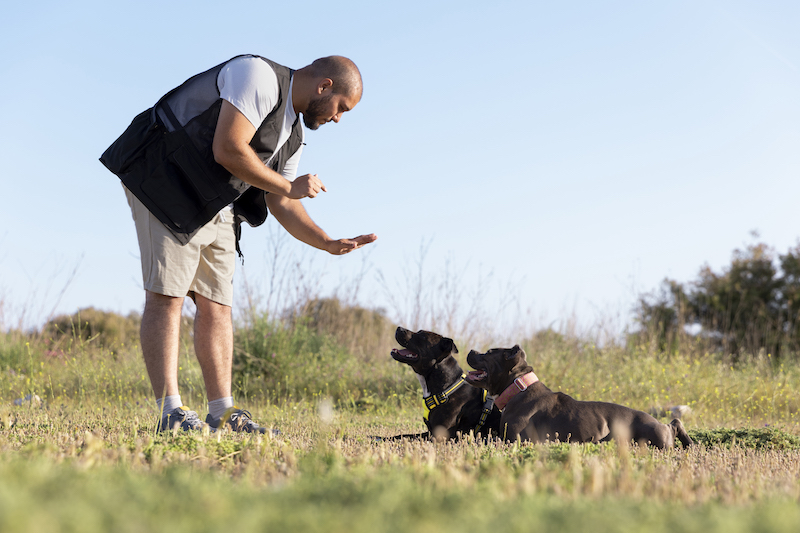Training a dog can feel like a daunting task, but with the right guidance and a bit of patience, you can transform your furry friend into a well-behaved companion. Using platforms like Dailymotion, you can access a treasure trove of video guides that make the learning process much easier and more enjoyable. In this post, we’ll cover some simple steps that will help you train your dog to follow commands effectively, as well as delve deeper into understanding their behavior. Let’s get started!
Understanding Dog Behavior

To train your dog successfully, it’s essential to understand what makes them tick. Here are some key points to help you grasp their behavior:
- Pack Mentality: Dogs are pack animals, which means they crave structure and leadership. They thrive under a clear hierarchy, and as their owner, you must establish yourself as the leader of the pack.
- Body Language: Dogs communicate primarily through body language. Pay attention to their posture, tail position, and ear orientation. For example, a wagging tail often means happiness, while a tucked tail may indicate fear or submission.
- Learning Style: Every dog is unique with its own learning style. Some dogs respond better to verbal commands, while others might learn faster through visual cues or physical interactions.
- Positive Reinforcement: Like humans, dogs respond well to positive reinforcement. Rewarding good behavior with treats, praise, or playtime will encourage them to repeat those behaviors.
- Short Attention Span: Dogs generally have a short attention span, particularly during training sessions. Keeping your sessions brief, around 5 to 10 minutes, can help maintain their focus and interest.
By understanding these behaviors, you can tailor your training approach to suit your dog’s needs better. Make sure to observe your dog closely and adjust your methods as necessary. With time and commitment, you'll create a stronger bond and see remarkable results in their training!
Also Read This: How Far Is Tattoo Far? Watch the Show on Dailymotion
The Importance of Consistency in Training

When it comes to training your dog, consistency is key. Just like how we thrive on routine, our furry friends do too! Developing a consistent training approach helps your dog understand what is expected of them. Here’s why consistency is so important:
- Building Trust: Dogs are creatures of habit. They feel more secure when they know what’s expected from them. Consistent commands and reactions from you build trust and encourage your dog to look to you for guidance.
- Reinforcing Learning: Using the same commands and cues helps reinforce learning. If you teach your dog “sit” and sometimes use “sit down” instead, they might get confused. Sticking to the same words and tone helps your dog make connections faster.
- Creating Positive Habits: Just like us, dogs learn through repetition. Consistent training sessions help establish positive habits. The more consistently you reward good behavior, the more likely your dog will repeat it.
- Avoiding Confusion: Mixed messages lead to a confused pup. If you react differently on different days, your dog won’t know what behavior you want to encourage. Consistency helps clarify expectations and results in a more well-behaved dog.
To maintain consistency, consider creating a training schedule. Dedicate time each day to practice commands, using the same words, gestures, and rewards. Over time, your dog will learn that responding to these cues leads to positive outcomes!
Also Read This: How to Apply Makeup Like a Pro: A Complete Guide on Dailymotion
Basic Commands to Teach Your Dog

Teaching your dog basic commands is an essential step in training. Not only does it enhance your communication, but it also helps keep your dog safe. Here are some fundamental commands to get you started:
| Command | Description | Tips for Training |
|---|---|---|
| Sit | This command asks your dog to sit down and stay there. | Hold a treat above their nose and move it upwards; they’ll naturally sit down to follow it. |
| Stay | This keeps your dog in one place until released. | Start with short durations and gradually increase the time as they get better. |
| Come | This command brings your dog to you when called. | Use a cheerful tone and reward them generously when they come. |
| Down | This command signals your dog to lie down. | Guide them into a lying position using a treat, then reward them immediately. |
| Leave it | This teaches your dog to ignore unwanted items. | Use treats to encourage them to choose you instead of the distraction. |
Beginning with these foundational commands helps establish a solid understanding of communication between you and your dog. Remember to use positive reinforcement—praise, treats, or playtime—to reward your dog’s efforts. Most of all, keep it fun and engaging; training should be a joyful experience for both of you!
Also Read This: How to Sync Dailymotion Videos on iPad Without Losing Data
Utilizing Dailymotion for Visual Learning
When it comes to training your dog, sometimes seeing is believing. That’s where Dailymotion comes into play! This platform is loaded with a plethora of videos that showcase different dog training techniques and tricks. Here’s how you can utilize Dailymotion for effective visual learning:
- Search for Tutorials: Use specific keywords like “dog training basics” or “how to teach a dog to sit” on Dailymotion. You’ll be surprised at the wealth of video content available.
- Watch Expert Trainers: Observe professional dog trainers as they demonstrate techniques. Pay close attention to their body language and how they interact with the dogs.
- Learn Through Different Perspectives: Different trainers have unique methods. Watch multiple videos to gather different tips and tricks that you can apply to your own sessions.
- Follow Along: Utilize the pause and rewind functions to follow along with your dog. This turns the videos into interactive learning sessions.
- Join the Community: Many Dailymotion videos have comment sections where users share their experiences. Engaging with this community can offer you insights and motivation.
So, next time you’re ready to train your furry friend, pull up Dailymotion, find those instructional gems, and turn your training sessions into fun, video-infused experiences!
Also Read This: How to Remove the Back Cover of an iPhone 5s with Dailymotion Videos
Creating a Positive Training Environment
The environment where you train your dog can make all the difference. A positive training environment is crucial for fostering trust and enthusiasm in your furry companion. Let’s explore how you can create the best atmosphere for training:
- Choose a Quiet Space: Pick an area that’s free from distractions. This allows your dog to focus solely on you and the commands you’re teaching.
- Ensure Comfort: Make sure the training area is comfortable for your dog. This could mean having some water available or a soft mat to sit on.
- Use High-Value Rewards: Keep treats handy, especially those that your dog loves. Positive reinforcement is essential for encouraging good behavior!
- Be Patient and Calm: Dogs pick up on their owners’ emotions. If you’re feeling frustrated, your dog will too. Stay calm—you've got this!
- Regular Breaks: Just like us, dogs need breaks. Keep training sessions short (10-15 minutes) and offer playtime to keep things enjoyable.
By creating a positive training environment, you not only enhance learning but also strengthen the bond between you and your dog. After all, a happy pup is a willing learner!
Also Read This: How to Make Chicken Nihari Traditional Recipe on Dailymotion
Common Mistakes to Avoid
Training your dog can be both rewarding and frustrating at times. To ensure that your training sessions are effective and enjoyable for both you and your furry friend, it’s essential to avoid these common mistakes:
- Inconsistency: When you don’t use the same command or cues every time, your dog can become confused. Stick to one clear command for each action.
- Negative Reinforcement: Using punishment can create fear, making it harder for your dog to learn. Focus on positive reinforcement instead, which encourages desired behavior.
- Lack of Patience: Dogs learn at their own pace. If you rush the process, you might create anxiety. Make sure to give them time to understand what you’re asking.
- Not Ending on a Positive Note: Always try to conclude training sessions with a success. This builds confidence and encourages your dog to look forward to future training.
- Ignoring Distractions: Begin training in a quiet environment before introducing distractions. If a dog is overwhelmed, they may not focus on the commands.
- Skipping Basic Commands: Don’t rush into advanced commands without mastering the basics. Building a strong foundation is crucial for any future training.
By being mindful of these common pitfalls, you’ll create a more effective and pleasant training experience for you and your dog. Remember, patience and consistency are key!
Also Read This: How Engines Work: Animation Videos on Dailymotion
Advanced Command Training Techniques
Once your pooch has mastered the basic commands, it’s time to dive into more advanced training techniques that can enrich their skills and deepen your bond. Here are some effective methods to consider:
- Clicker Training: This technique uses a small device to produce a clicking sound, which marks the exact moment your dog performs the desired action. Pair this with a treat to reinforce the behavior.
- Target Training: Teach your dog to touch or follow a target, like your hand or a stick. This can help in teaching complex commands, as they learn to navigate their space more confidently.
- Shaping Behavior: Break down complicated commands into smaller, manageable steps. Reward your dog for approximations of the final behavior—this helps them learn progressively.
- Leash Pressure Training: Use light pressure on the leash as a cue for your dog to either stop or change direction. This technique can refine their understanding of directional commands.
- Distraction Training: Gradually introduce distractions while practicing commands. Each success will boost their focus and reliability in various environments.
With these advanced techniques, you're not just training your dog to follow commands but also enhancing their overall responsiveness and understanding. Make the journey fun, and don’t forget to celebrate the victories, no matter how small!
Also Read This: Mastering Polymer Clay Techniques with Dailymotion Tutorials
9. Monitoring Progress and Adjusting Methods
Training a dog is an in-depth process, and just like with any relationship, it requires ongoing attention and adaptation. Monitoring your dog's progress is crucial to ensure they are learning effectively and happily. So, how can you do this? Here are some tips:
- Observe Behavior: Pay close attention to how your dog responds to commands. Are they eagerly following your cues, or do they seem disinterested?
- Track Success Rates: Keep a record of how often your dog successfully follows commands. This could be simple notes on a calendar or a training app.
- Adjust Reward Systems: If your dog is not motivated, consider changing the type of rewards you offer. Some dogs respond better to treats, while others might prefer playtime or affection.
- Change Environments: Train in different locations. Sometimes dogs may do well at home but struggle in public places. Make sure you train in a variety of settings.
Remember, if you notice a plateau in progress, it might be time to switch up your training methods. Just like humans, dogs can get bored with repetitive tasks. Incorporating new techniques or challenges can make a world of difference.
Lastly, always celebrate the small wins, whether it’s a wag of the tail or a successful command. This positive reinforcement not only boosts your dog’s confidence but also solidifies the bond between the two of you!
10. Conclusion and Encouragement to Continue Training
Training a dog is not just about teaching commands; it’s an enriching journey that strengthens your bond and creates lasting memories. As you reach the end of this guide, let’s remember a few key takeaways: it’s all about patience, consistency, and understanding your furry friend’s needs.
As you move forward, here’s a little encouragement:
- Stay Positive: Remember that some days will be better than others, and that’s perfectly normal.
- Celebrate Milestones: Whether it's your dog sitting on command or simply staying focused during training, celebrate every accomplishment—big or small.
- Utilize Resources: Don’t forget about Dailymotion guides and videos that can provide new ideas and techniques. Sometimes a fresh perspective is all it takes!
Lastly, keep the training sessions fun! Incorporate play and change things up to keep your dog engaged. The love and trust you build through training will last a lifetime, so take a breath, enjoy the moments, and remember: every command learned brings you closer together. Happy training!
 admin
admin








